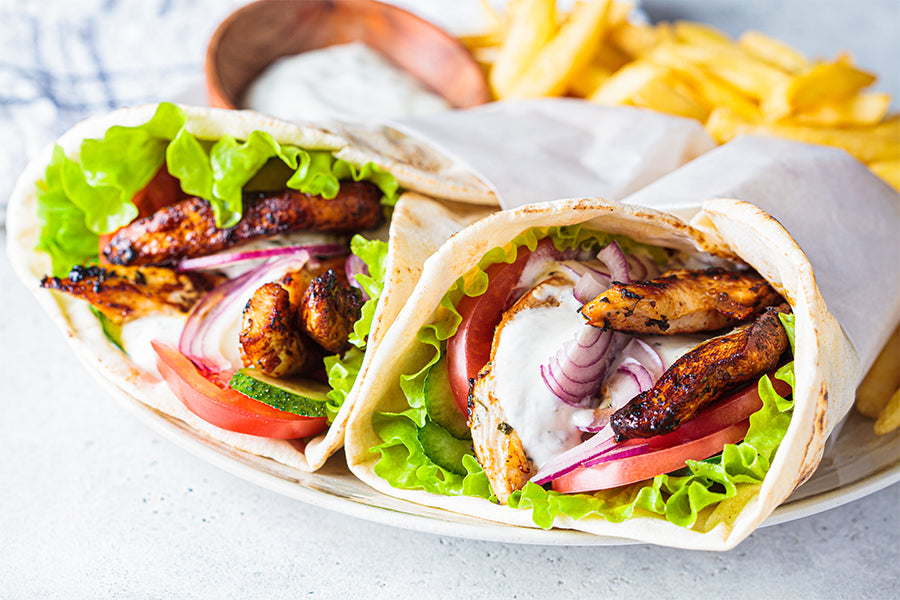Looking for a meal packed with protein? This is the right one for you. In just a few minutes, you can treat your taste buds with something loaded with protein and a delicious flavor. Having this dish will offer you health benefits without sacrificing the flavor. It’s easy to cook and takes less time to prepare.
Its recipe is so simple that even a beginner can try their hands on preparing the grilled chicken gyros. It’s a combination of chicken with sausages and veggies all wrapped up in a soft pita. In addition, chicken is a healthy and delightful addition to the breakfast table. The key to making this dish is a good quality chicken. Other than that, if you are hunting for something delicious to start your day, this Grilled Chicken Gyros is the right meal to hit the spot.
Nutrition Facts
Serves 4 persons
|
Calories |
359 cal |
|
Carbohydrates |
22.5g |
|
Protein |
57.7g |
|
Fats |
7.9g |
Time Required
|
Preparation Time |
60 Minutes |
|
Cooking Time |
10 Minutes |
|
Total Time |
1 Hour and 10 Minutes |
Ingredients
- 8 low carb pitas
- 24 oz chicken breast, cut into cubes
- 1.5 tsp olive oil
- 1.5 tbsp red wine vinegar
- 1¼ tsp garlic powder
- 2 tsp fresh lemon juice
- 1.5 tbsp oregano
- 1 cup diced tomato
- 1 cup chopped red onion
- 1 cup chopped cucumber
Tatziki Sauce Ingredients
- ½ cup non-fat Greek yogurt
- ½ tsp dry dill
- Splash of lemon juice
- Salt & Pepper, to taste
Cooking Instructions
- Mix all ingredients for Tatziki sauce and place in the refrigerator.
- Add chicken, olive oil, vinegar, garlic powder, lemon juice, and oregano to a container or plastic bag. Toss and allow to marinate for 1 hour.
- Remove chicken from the container and grill until cooked through. Evenly divide chicken between 8 pitas.
- Top with tomato, cucumber, onion, and tatziki sauce.
Why Do People Need to Add More Protein to Their Diets?
Most people eat a protein-enriched diet to prevent deficiency, while some add it to their diet routines. Several studies suggest that the protein-loaded diet has a beneficial impact on weight loss and boosting metabolism.
Here are five science-based reasons why people need more protein to eat.
Enhances Metabolism and Boosts Fat Burning
Did you know protein has a higher thermic effect than carbs and fats? A thermic effect is a condition in which the body uses calories to digest food and use the nutrients in food. However, not all foods have the thermic effect as protein. A higher dietary protein boosts the metabolism and helps burn 80 to 100 calories daily. Research showed a higher protein intake group burned 260 calories per day compared to the low protein group.
Beneficial for Bones
The role of dietary protein in improving and maintaining bone health is exceptional. Protein is the main component that helps improve calcium absorption by the bones. In addition, a high protein intake helps to prevent osteoporosis as well. A study shows the effect of protein in maintaining bone mass and preventing them from injury or catching any bone disease.
Helps Maintain Weight Loss
If you want to lose weight and prevent yourself from regaining weight, consider increasing protein intake in your diet. Several studies support the role of high protein intake in shedding some pounds compared to those on low protein intake. Since protein plays a major role in boosting metabolism, it reduces calorie intake and causes weight loss. One study shows that overweight women who took 30% calories from the protein lost 11 pounds in twelve weeks. In another study, it was found that those who increased protein from 15% to 18% of calories reduced weight regain by 50%.
Related Article: Easy Eggs 'n' Sausage Breakfast Burrito Recipe – DMoose
Keeps You Stay Fit As You Age
One of the bad effects of aging is weakening bones and muscles. The most severe conditions are referred to as sarcopenia related to aging. It causes frailty, bone fractures, and poor quality of life among older adults. Eating a protein-rich diet helps you prevent age-related sarcopenia and keeps you active. Not to mention, adding resistance training or any workout along with taking protein will do wonders.
Increase Muscle Mass & Strength
Protein is the building block of muscles. If you lift heavy weights or do resistance training, your body needs protein to maintain muscle mass. Eating adequate protein helps you grow muscle mass and maintain its growth. According to a study, higher protein intake increases muscle mass and strength. Furthermore, a review shows the effective role of protein-rich meals in preventing muscle loss during weight loss.
With tons of protein benefits, adding DMoose Essential Amino Acids to diet is recommended. Since the body doesn’t create them itself, it is necessary to take them through diet or supplements. EAAs play a major role in preventing muscles from breaking down during exercise and help damaged muscles heal safely.
Related Article: Guide to Maintaining Muscle Mass in a Calorie Deficit - 7 Tips to Follow
Conclusion
Having grilled chicken gyro on the dinner table is not only a tasty dish, but you can treat your body with the essential protein. This meal doesn’t only have protein but other nutrients too. You can prepare it easily at home. Furthermore, this recipe is going to affect your health positively. The presence of protein will improve your metabolism, enhance bone health, curb appetite, increase muscle mass and maintain weight loss. With so many benefits, enjoy the meal to stay healthy and active.
Reading List
Article Sources
- Noakes, M., Keogh, J. B., Foster, P. R., & Clifton, P. M. (2005). Effect of an energy-restricted, high-protein, low-fat diet relative to a conventional high-carbohydrate, low-fat diet on weight loss, body composition, nutritional status, and markers of cardiovascular health in obese women. The American Journal of Clinical Nutrition, 81(6), 1298–1306. https://doi.org/10.1093/ajcn/81.6.1298
- Westerterp-Plantenga, M. S. (2008). Protein intake and energy balance. Regulatory Peptides, 149(1-3), 67–69. https://doi.org/10.1016/j.regpep.2007.08.026
- Bosse, J. D., & Dixon, B. M. (2012). Dietary protein to maximize resistance training: a review and examination of protein spread and change theories. Journal of the International Society of Sports Nutrition, 9(1). https://doi.org/10.1186/1550-2783-9-42
- METTLER, S., MITCHELL, N., & TIPTON, K. D. (2010). Increased Protein Intake Reduces Lean Body Mass Loss during Weight Loss in Athletes. Medicine & Science in Sports & Exercise, 42(2), 326–337. https://doi.org/10.1249/mss.0b013e3181b2ef8e
- Bonjour, J.-P. (2011). Protein Intake and Bone Health. International Journal for Vitamin and Nutrition Research, 81(23), 134–142. https://doi.org/10.1024/0300-9831/a000063
- Hannan, M. T., Tucker, K. L., Dawson-Hughes, B., Cupples, L. A., Felson, D. T., & Kiel, D. P. (2000). Effect of Dietary Protein on Bone Loss in Elderly Men and Women: The Framingham Osteoporosis Study. Journal of Bone and Mineral Research, 15(12), 2504–2512. https://doi.org/10.1359/jbmr.2000.15.12.2504
- Johnston, C. S., Day, C. S., & Swan, P. D. (2002). Postprandial thermogenesis is increased 100% on a high-protein, low-fat diet versus a high-carbohydrate, low-fat diet in healthy, young women. Journal of the American College of Nutrition, 21(1), 55–61. https://doi.org/10.1080/07315724.2002.10719194
- Paddon-Jones, D., Westman, E., Mattes, R. D., Wolfe, R. R., Astrup, A., & Westerterp-Plantenga, M. (2008). Protein, weight management, and satiety. The American Journal of Clinical Nutrition, 87(5), 1558S1561S. https://doi.org/10.1093/ajcn/87.5.1558s
- Westerterp-Plantenga, M. S., Lejeune, M. P. G. M., Nijs, I., van Ooijen, M., & Kovacs, E. M. R. (2003). High protein intake sustains weight maintenance after body weight loss in humans. International Journal of Obesity, 28(1), 57–64. https://doi.org/10.1038/sj.ijo.0802461
- Rizzoli, R., Reginster, J.-Y., Arnal, J.-F., Bautmans, I., Beaudart, C., Bischoff-Ferrari, H., Biver, E., Boonen, S., Brandi, M.-L., Chines, A., Cooper, C., Epstein, S., Fielding, R. A., Goodpaster, B., Kanis, J. A., Kaufman, J.-M., Laslop, A., Malafarina, V., Mañas, L. R., & Mitlak, B. H. (2013). Quality of Life in Sarcopenia and Frailty. Calcified Tissue International, 93(2), 101–120. https://doi.org/10.1007/s00223-013-9758-y
- Paddon-Jones, D., Short, K. R., Campbell, W. W., Volpi, E., & Wolfe, R. R. (2008). Role of dietary protein in the sarcopenia of aging. The American Journal of Clinical Nutrition, 87(5), 1562S1566S. https://doi.org/10.1093/ajcn/87.5.1562s








